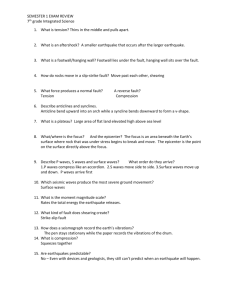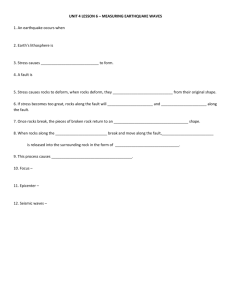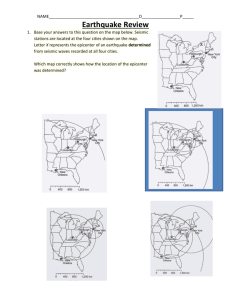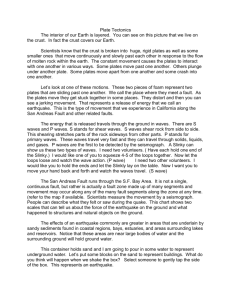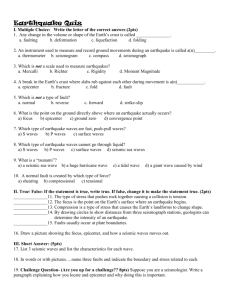Geology – EXAM-1 Fall-2009
advertisement
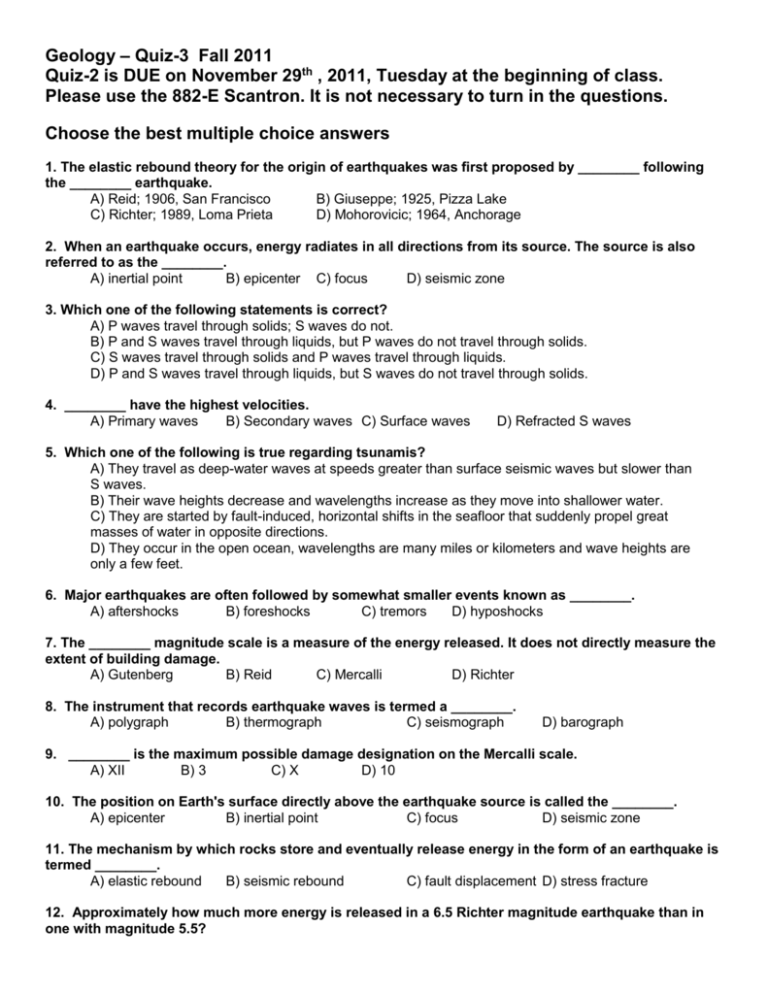
Geology – Quiz-3 Fall 2011 Quiz-2 is DUE on November 29th , 2011, Tuesday at the beginning of class. Please use the 882-E Scantron. It is not necessary to turn in the questions. Choose the best multiple choice answers 1. The elastic rebound theory for the origin of earthquakes was first proposed by ________ following the ________ earthquake. A) Reid; 1906, San Francisco B) Giuseppe; 1925, Pizza Lake C) Richter; 1989, Loma Prieta D) Mohorovicic; 1964, Anchorage 2. When an earthquake occurs, energy radiates in all directions from its source. The source is also referred to as the ________. A) inertial point B) epicenter C) focus D) seismic zone 3. Which one of the following statements is correct? A) P waves travel through solids; S waves do not. B) P and S waves travel through liquids, but P waves do not travel through solids. C) S waves travel through solids and P waves travel through liquids. D) P and S waves travel through liquids, but S waves do not travel through solids. 4. ________ have the highest velocities. A) Primary waves B) Secondary waves C) Surface waves D) Refracted S waves 5. Which one of the following is true regarding tsunamis? A) They travel as deep-water waves at speeds greater than surface seismic waves but slower than S waves. B) Their wave heights decrease and wavelengths increase as they move into shallower water. C) They are started by fault-induced, horizontal shifts in the seafloor that suddenly propel great masses of water in opposite directions. D) They occur in the open ocean, wavelengths are many miles or kilometers and wave heights are only a few feet. 6. Major earthquakes are often followed by somewhat smaller events known as ________. A) aftershocks B) foreshocks C) tremors D) hyposhocks 7. The ________ magnitude scale is a measure of the energy released. It does not directly measure the extent of building damage. A) Gutenberg B) Reid C) Mercalli D) Richter 8. The instrument that records earthquake waves is termed a ________. A) polygraph B) thermograph C) seismograph D) barograph 9. ________ is the maximum possible damage designation on the Mercalli scale. A) XII B) 3 C) X D) 10 10. The position on Earth's surface directly above the earthquake source is called the ________. A) epicenter B) inertial point C) focus D) seismic zone 11. The mechanism by which rocks store and eventually release energy in the form of an earthquake is termed ________. A) elastic rebound B) seismic rebound C) fault displacement D) stress fracture 12. Approximately how much more energy is released in a 6.5 Richter magnitude earthquake than in one with magnitude 5.5? A) 3000 times B) 3 times C) 300 times 13. P waves ________. A) propagate only in solids C) have higher amplitudes than do S waves D) 30 times B) are faster than S waves and surface waves D) produce the strongest ground shaking 14. The Mercalli Scale is a scale from ________. A) 1 to 12 that rates the energy required for faulting to occur B) 1 to 10 that rates the energy released by an earthquake C) I to XII that rates the structural damage due to an earthquake D) I to X that rates the total energy released during the main quake and all aftershocks 15. Most of our knowledge about Earth's interior comes from ________. A) drill holes B) volcanic eruptions C) seismic waves D) examination of deep mine shafts 16. Which one of the following statements about the crust is NOT true? A) It is the thinnest of the major subdivisions. B) It is thickest where prominent mountains exist. C) Oceanic crust is enriched in potassium, sodium, and silicon. D) Continental rocks are compositionally different than oceanic rocks. Identify the following earthquake terminology in the diagram below 17 18 19 20 17. 18. 19. 20. a. focus a. focus a. focus a. focus b. epicenter b. epicenter b. epicenter b. epicenter c. seismic waves c. seismic waves c. seismic waves c. seismic waves d. fault d. fault d. fault d. fault 21. The Rayleigh wave a. motion similar to an ocean wave b. travels along the surface exhibiting horizontal motion c. motion that travels along the surface producing a “rolling” effect d. is a compressional wave compressing and expanding rock material 22. An earthquake measuring 6.3 on the Richter scale is ____________ times more powerful than an earthquake measuring 4.3 on the Richter scale. a. 10 b. 100 c. 20 d. 1000 23. There are about 600,000 earthquakes annually that range in magnitude a. Greater than M8 b. less than M2 c. M4 to M5 d. M3 24. A Mercalli intensity earthquake of roman numeral 2 would indicate a. A major earthquake b. a very lightly felt EQ c. major damage 25. Which of the following correctly lists the order in which seismic waves arrive at the seismograph station a. P waves surface waves S waves b. S waves P waves Surface waves c. P waves S waves Surface waves d. Surface waves P waves S waves 26. Which of the following has been used, with some success, to make long-term predictions about the location of future large earthquakes? a. the seismic gap method b. the principle of cross cutting relations c. the elastic rebound theory d. all of these 27. Which of the following describes the build-up and release of stress during an earthquake? a. Mercalli Scale b. elastic rebound theory c. principle of superposition d. the seismic gap method 28. A ________ fault has little or no vertical movements of the two blocks. A) stick slip B) oblique slip C) strike slip D) dip slip 29. In a ________ fault, the hanging wall block moves up with respect to the footwall block. A) normal B) inverse C) reverse D) abnormal 30. In thrust faulting, ________. A) grabens develop on the footwall block B) the crust is shortened and thickened C) horizontal, tensional stresses drive the deformation D) the hanging wall block slips downward along the thrust fault 31. Which one of the following stress situations results in folding of flat-lying, sedimentary strata? A) horizontally directed; compressive stresses B) vertically directed; extensional or stretching stresses C) horizontally directed; extensional stresses D) vertically directed; compressional stresses 32. The mountains and valleys of the Basin and Range Province of the western United States formed in response to ________. A) strike-slip faulting and hanging wall block uplifts B) reverse faults and large displacement, thrust faulting C) tensional stresses and normal-fault movements D) normal faulting and horizontal compression 33. In a normal fault ________. A) the hanging wall block below an inclined fault plane moves downward relative to the other block B) the footwall block below an inclined fault plane moves downward relative to the other block C) the hanging wall block above an inclined fault plane moves downward relative to the other block D) the footwall block above an inclined fault plane moves upward relative to the other block 34. A transform fault is ________. A) a strike-slip fault that forms the boundary between tectonic plates B) a dip-slip fault connecting an anticline with a syncline C) a reverse fault that steepens into a thrust fault D) the rift bounding faults on a mid-ocean ridge 35. A thrust fault is best described as ________. A) a steeply inclined, oblique-slip fault B) a low-angle, reverse fault C) a vertical, normal fault D) a near vertical, strike-slip fault 36. A syncline is ________. A) a fold in which the strata dip away from the axis B) a fold with only one limb C) a fold in which the strata dip toward the axis D) a fold characterized by recumbent limbs 37. Tensional forces normally cause which one of the following? A) strike-slip faults B) reverse faults C) normal faults D) thrust faults 38. Desert pavement is the result of ________. A) deflation B) abrasion by windblown sand C) erosion by running water D) intense chemical weathering 39. Desert and steppe lands cover about what percentage of Earth's land area? A) 10% B) 66% C) 30% D) 3% 40. What mature, desert landscape feature consists of coalesced alluvial fans? A) balda B) bajada C) bahia D) baja 41. Inselbergs are ________. A) insulated icebergs floating in a hot spring B) blowouts cut from bedrock in mountainous areas C) lithified rock formed by cementation of wind-deposited, dune sands D) bedrock hills in a highly eroded desert landscape 42. Which of the following statements about saltation is true? a. Saltating sand grains rise to greater heights in water than in air b. Saltating sand grains rise to greater heights in air than in water. c. Saltating sand grains rise to approximately the same height in air and in water d. Sand grains do not saltate in water or air. 43. The process by which the ground surface is lowered by wind erosion is called ___ a. deflation b. inflation c. ablation d. none of theses 44. Ventifacts are formed by a. sandblasting b. dissolution by dew c. breaking apart rocks d. all of these 45. Which of the following promote sand dunes? a. strong winds b. a supply of sand c. dry climate d. all of theses 46. Sand will accumulate on the _____ a. leeside (downwind) of a boulder b. windward side (upwind) of a boulder c. equally on the leeside and the windside d. neither the leeside or windside 47. Long wavy sand ridges that lie perpendicular to the prevailing wind are called a. barchans dunes b. linear dunes c. transverse dunes d. blowouts 48. In a barchans dune, the points of the crescent point ______ and the slip face is the ________ downward curve of the dune a. upwind…..concave b. upwind…….convex c. downwind…….concave d. downwind….convex 49. Which of the following statements are false? a. Deserts are common near 30 degree North latitude b. Deserts are common near the equator c. Deserts are common near 30 degree South latitude d. Some deserts occur in the rain shadow of large mountain ranges 50. Air rising over mountain ranges produce dry conditions on the leeward side creating rain shadow effects. This is known as: a. organic propagation b. orographic lifting c. oreocumalative progression d. none of these 51. ________ denotes the exposed, crescent-shaped rupture surface at the head of a slump. A) Scoop B) Sole C) Toe D) Scarp 52. Of the following, which one would most likely be triggered by an earthquake? A) solifluction B) soil creep C) slump D) rock avalanche 53. Which statement best describes slumping, a mass wasting process? A) a block or blocks of unconsolidated regolith slide downhill along a curved slip surface B) blocks of hard bedrock rapidly slide downhill along fracture surfaces C) the soil and regolith move downhill very slowly D) a mass of soil or regolith becomes saturated with water and suddenly flows downhill to the 54. Which mass wasting process has the slowest rate of movement? A) slump B) rock avalanche C) rock fall D) creep 55. All of the following are factors affecting mass wasting except for ________. A) gravity B) water C) slope angle D) geologic age 56. The most rapid type of mass movement is a ________. A) slump B) lahar C) rock avalanche D) debris flow 57. As an erosional process, how is mass wasting unique from wind, water, and ice? A) Mass wasting affects particles of all sizes whereas the others affect only smaller particles. B) Mass wasting does not require a transporting medium. C) Mass wasting affects much larger geographic areas than does wind, water, and ice. D) All of the above make mass wasting unique compared to wind, water, and ice. 58. Which of the following mass movements is most likely to occur in a geologic setting where the rock strata are inclined? A) debris flow B) slump C) creep D) rockslide 59. All of the following are possible indicators that creep is occurring except for ________. A) tilted fences or power line poles B) an extremely thick soil profile C) curved tree trunks D) cracks in roads or sidewalks



